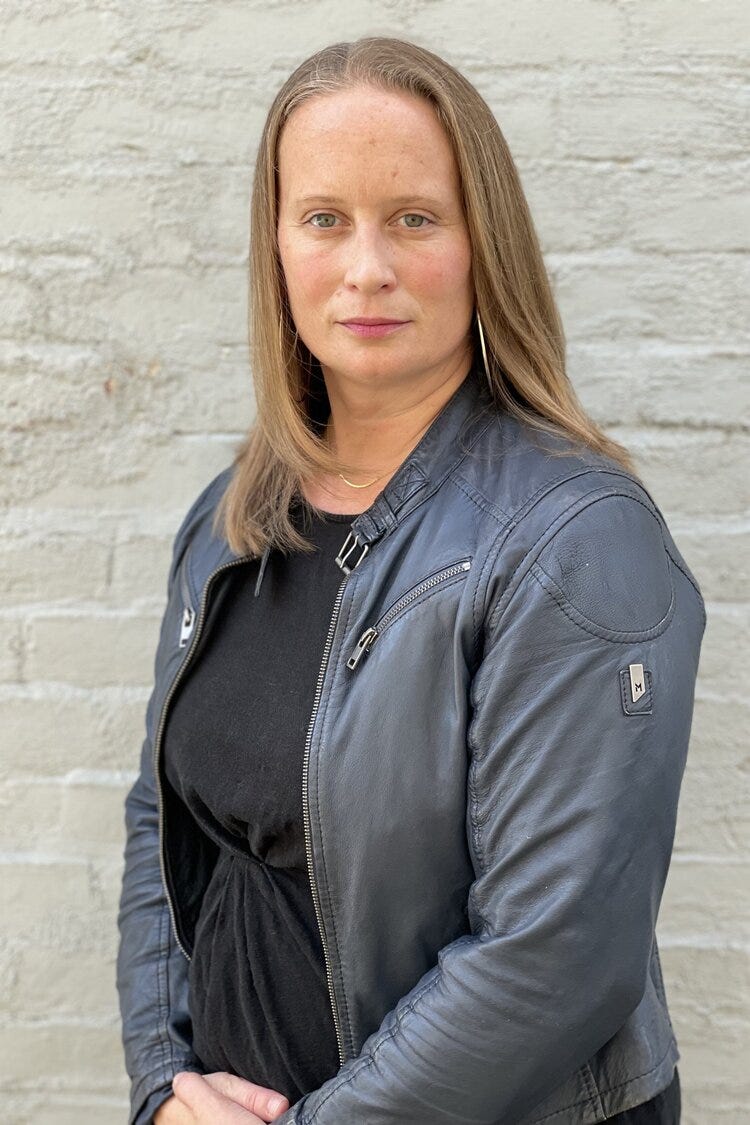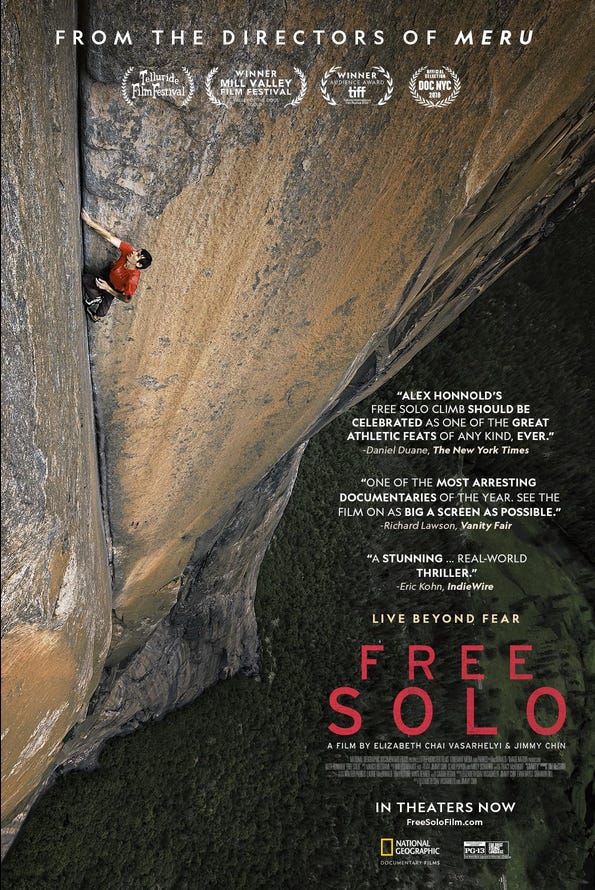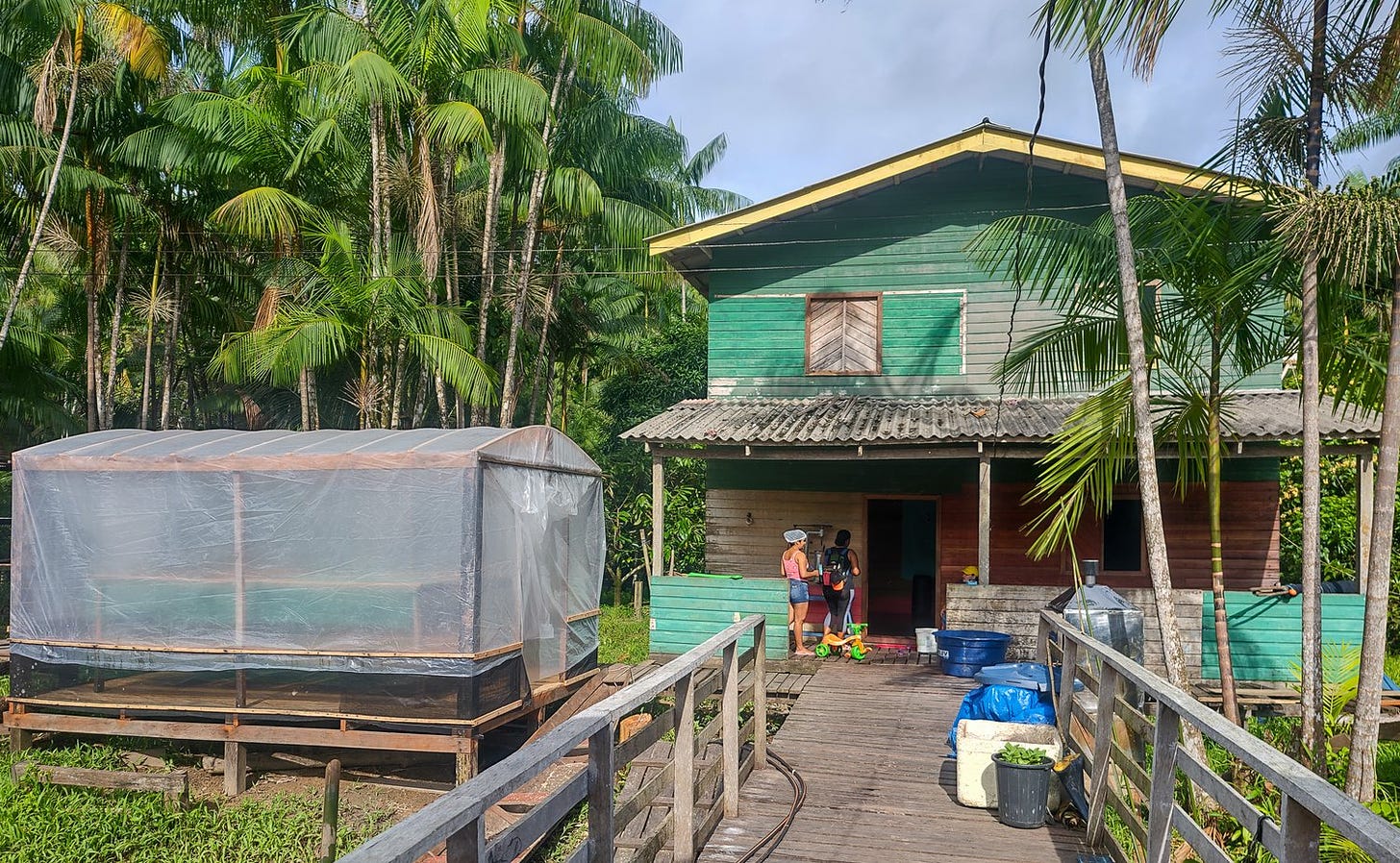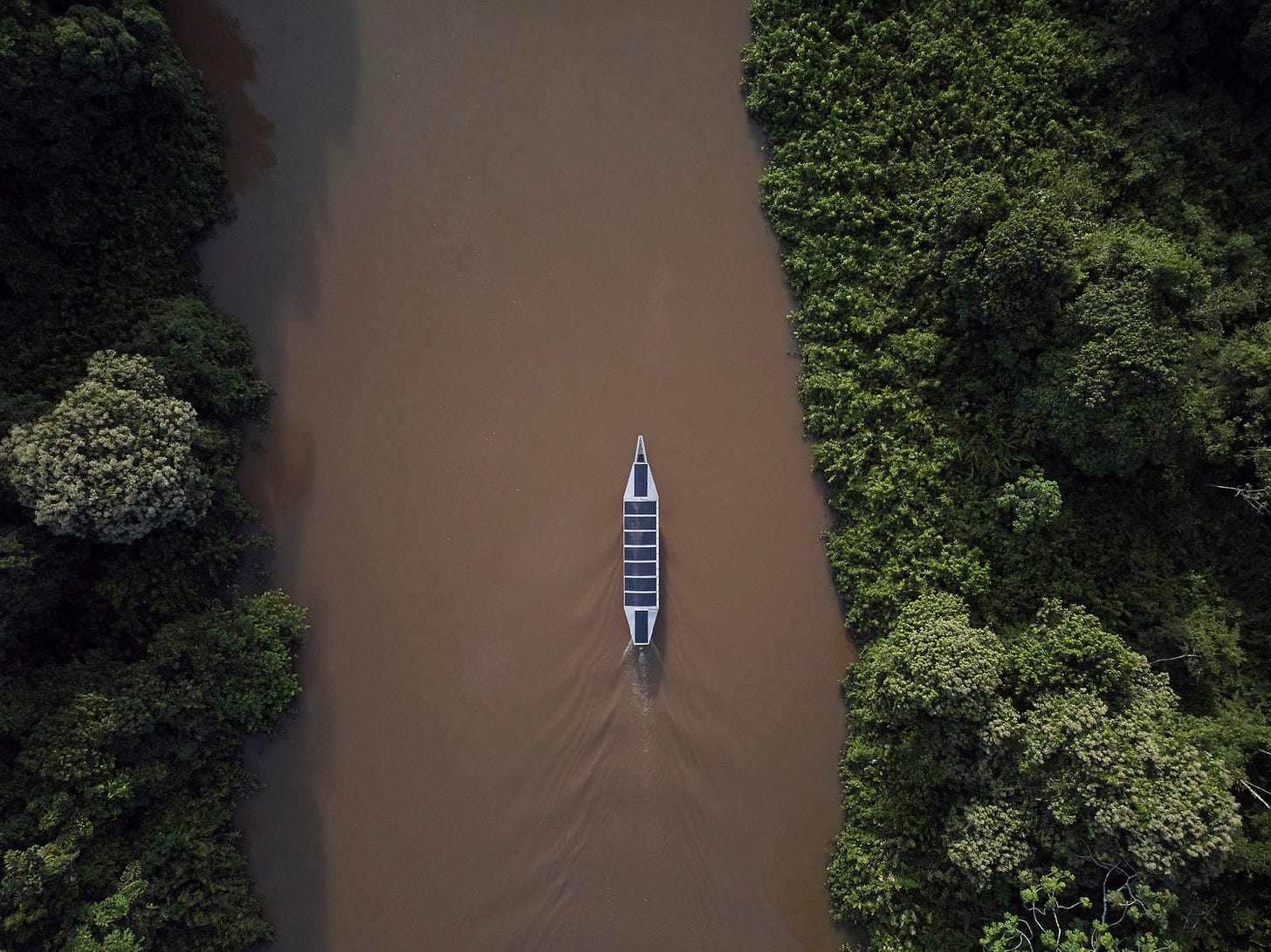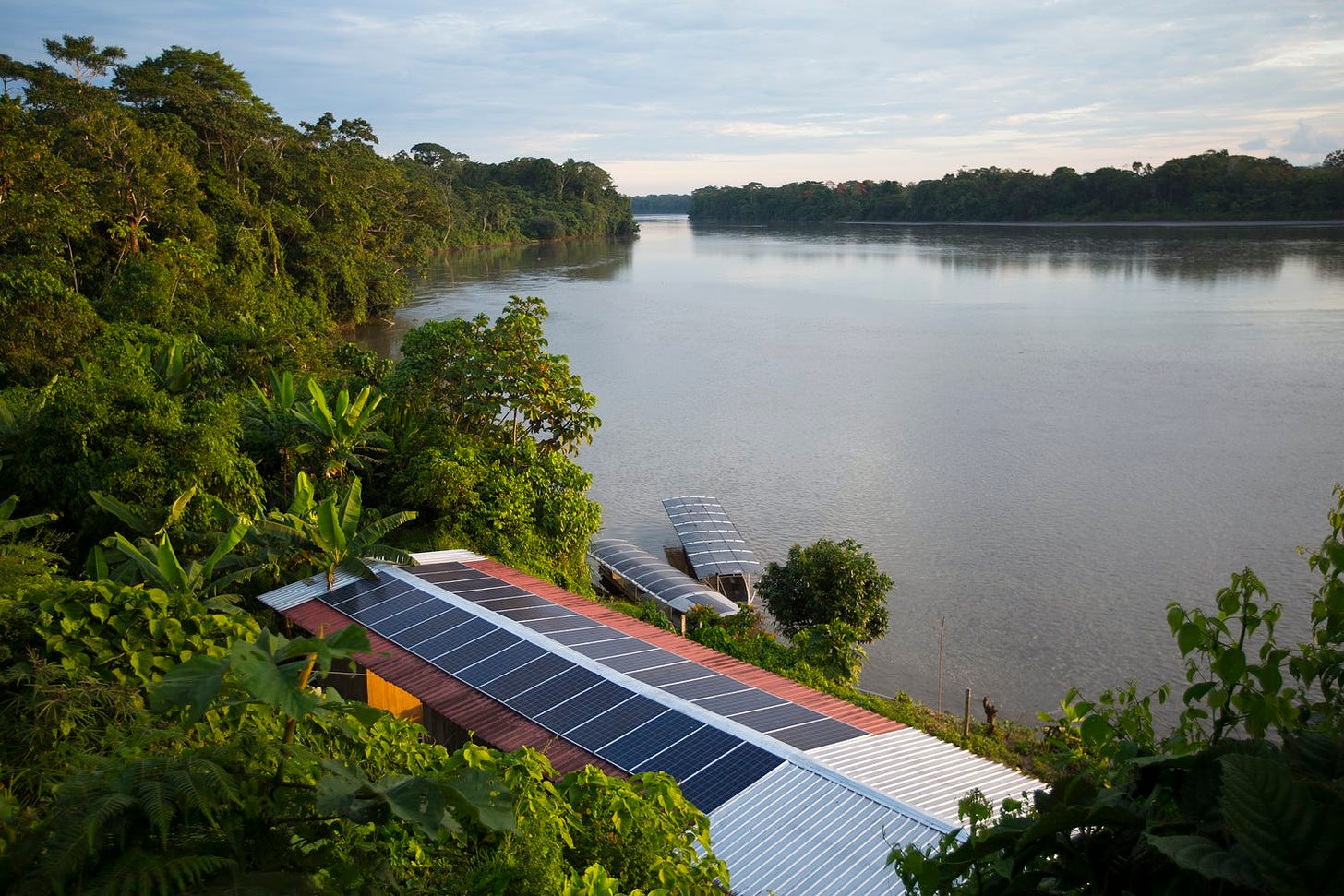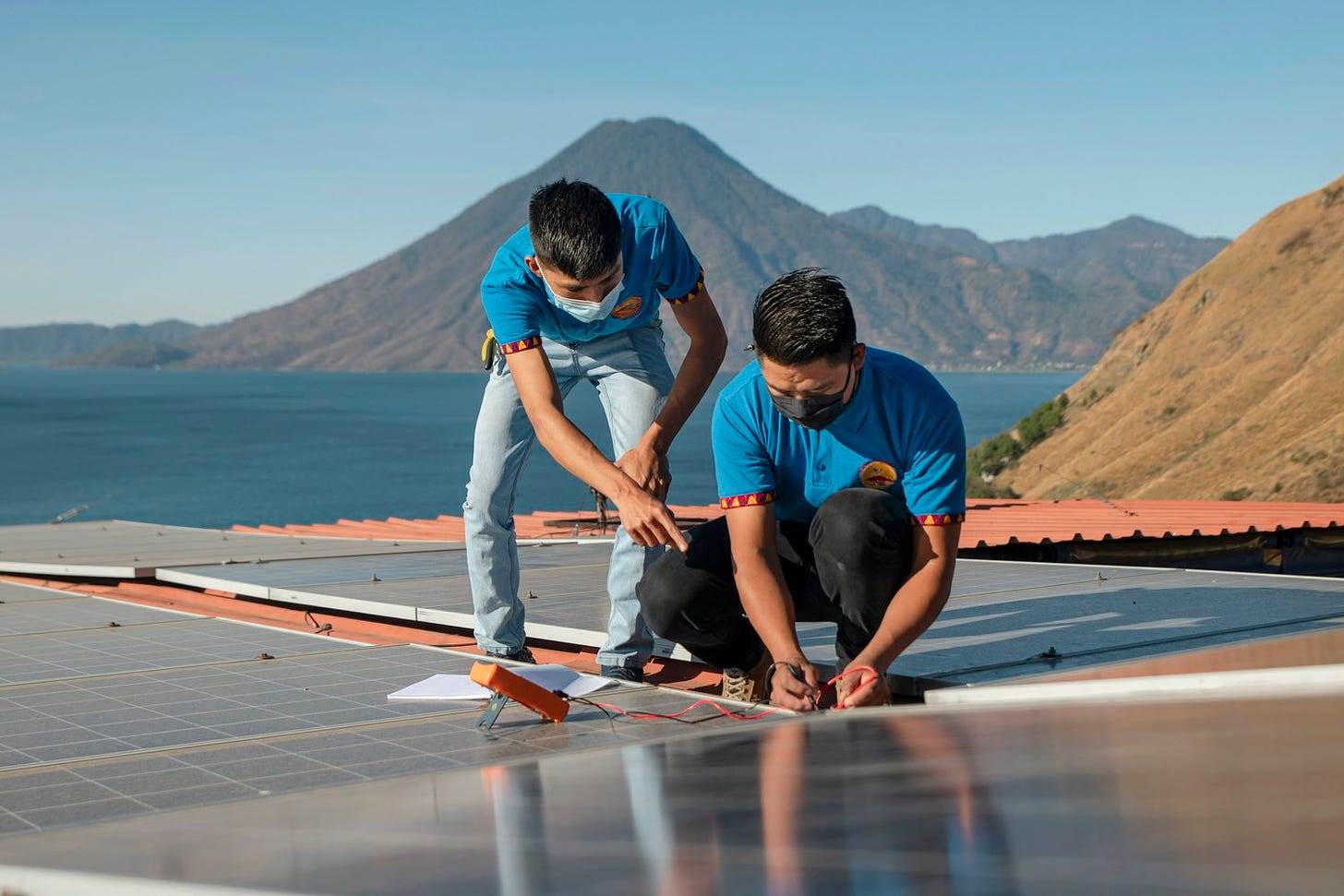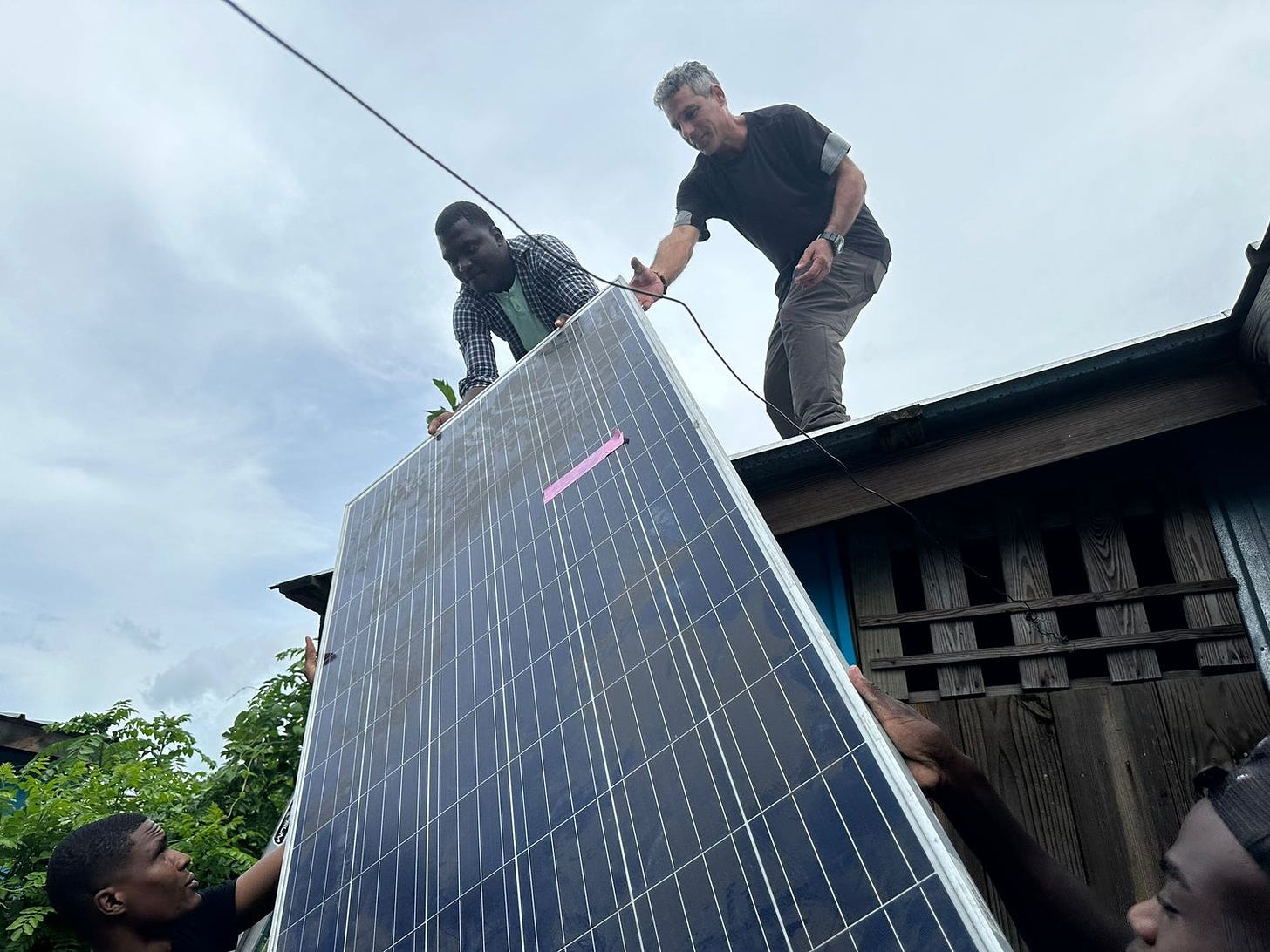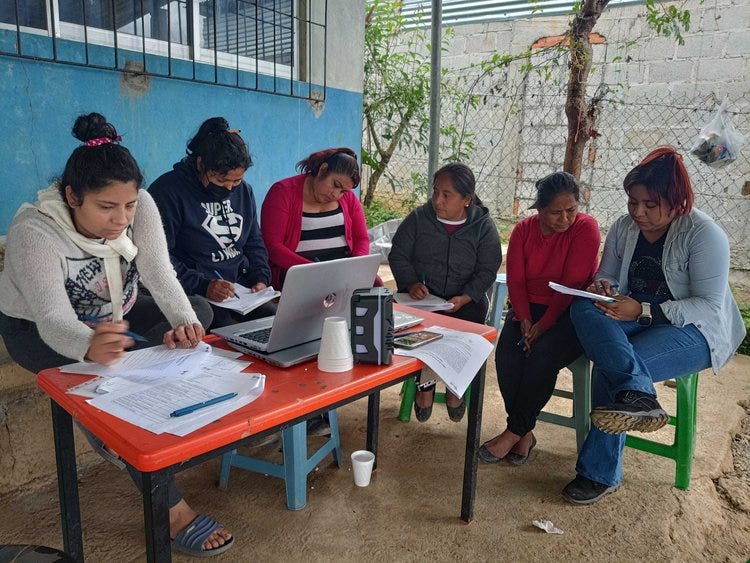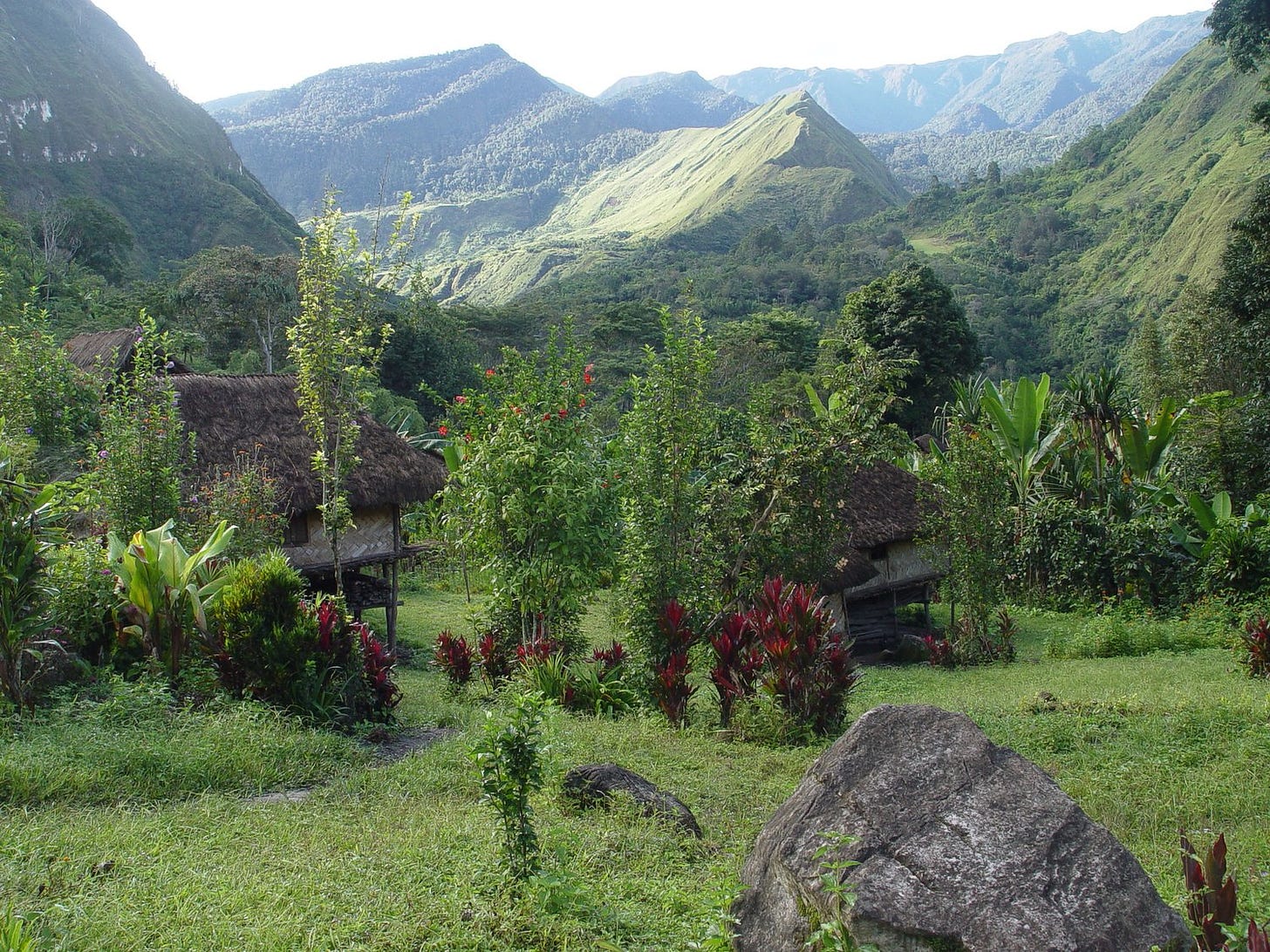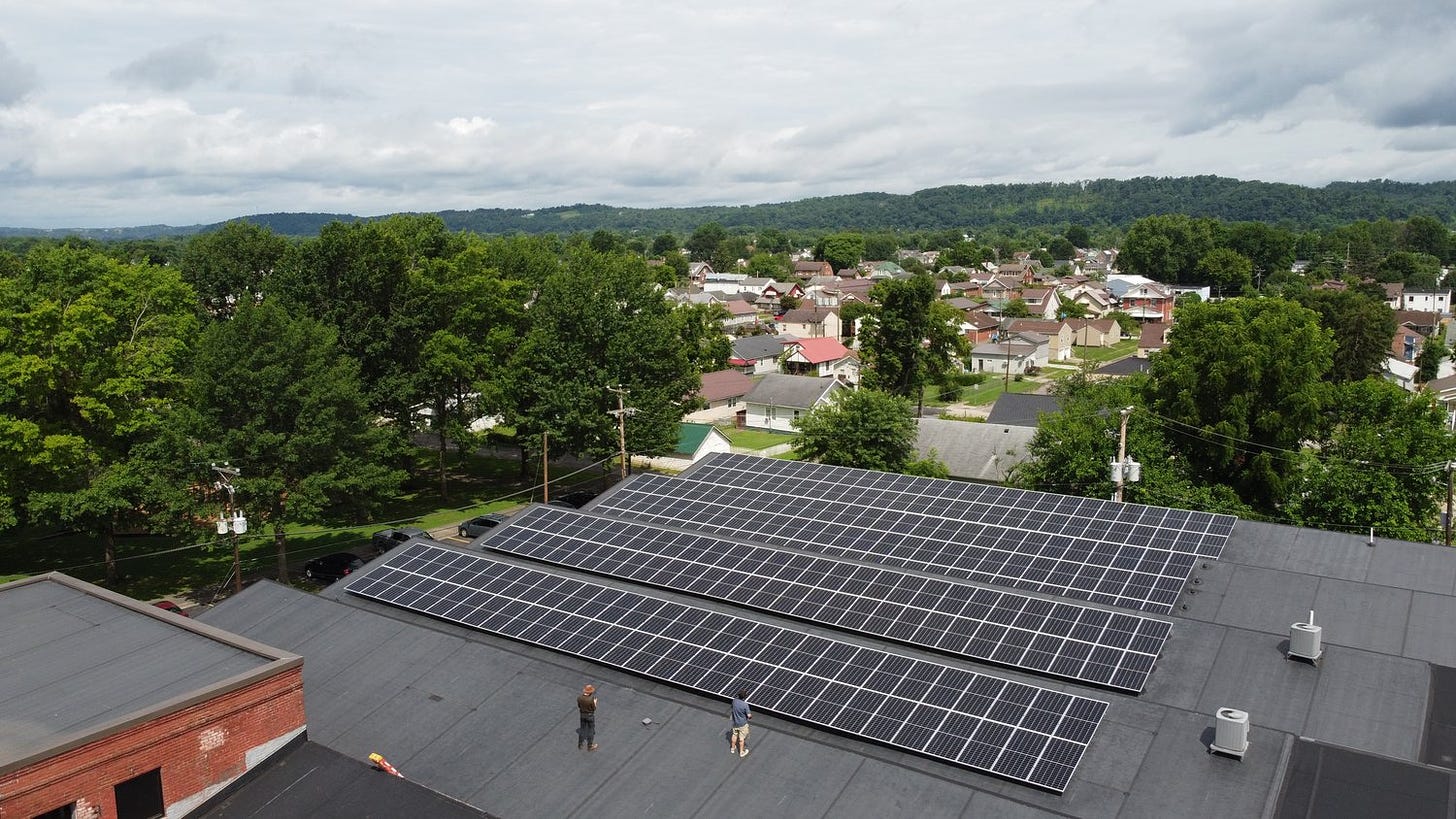Your Daily Dose of Climate Hope: Emily Teitsworth of the Honnold Foundation
Catalyzing community solar!
Emily Teitsworth is the Executive Director of the Honnold Foundation, founded by world-famous rock climber Alex Honnold to help bring solar power to marginalized communities around the world. This newsletter is a huge fan of Mr. Honnold's 2023 Earth Day Essay, and his spirit of optimistic, can-do heroic environmentalism.
A lightly edited transcript of this exclusive interview follows. This writer’s questions and remarks are in bold, Ms. Teitsworth’s responses are in regular type. Bold italics are clarifications and extra information added after the interview.
This interview is syndicated by both The Weekly Anthropocene and Your Daily Dose of Climate Hope.
Can you tell me how you came to lead the Honnold Foundation?
I believe it's been three years, and it's gone very quickly! Most of my career was focused on gender equity work and community development, and in particular, girls' human rights issues around education and health. I spent close to 15 years working on those issues. Close to the end of that time, a big global report came out showing that girls are the most impacted by climate change. Because around the world, they’re the ones that are having to drop out of school first if resources are scarce, they're the ones that have to go find water or firewood. The time and resource pressures on girls are really intense. I started to feel this personal urgency to do more work at that intersection of human rights and climate.
I came across the Honnold Foundation. I knew who Alex was, but pretty peripherally. I started to read about the foundation, and realized that the work that he had started and the staff team was leading was really unique, and that it is looking at climate and energy access from the lens and the perspective of the communities that are most impacted. And those tend to be the ones that are not getting the investment to enable them to make the renewables transition! I think that looking at these sort of technical problems from a really human perspective is what drew me to HF and what's kept me here.
Technical problems from a really human perspective, that's a great way of putting it.
Yeah! So Alex started the foundation in 2012. And at that time, it was a sponsored project of the Tides Foundation. He had started to climb around the world, and he saw when he was in Chad and Borneo and other places what it looked like for people to rely on diesel for their power or to not have any electricity access at all.
Right around the time that Free Solo came out, the foundation became its own independent 501c3 organization. [Free Solo is an award-winning documentary chronicling Alex Honnold’s unprecedented ascent of El Capitan with no ropes safety equipment]. When Alex founded the Honnold Foundation, it wasn't necessarily clear that it was inevitable that we were going to make this renewables transition, and I think it became really clear right around the time that I joined.
When was that exactly?
It became an independent nonprofit in 2018, and then I joined in 2021. Since that time, we've been lucky to continue to grow and build our partnerships with other funders and other people in the space who really want to ensure that the people who are most impacted by climate are not left out of the energy transition. There’s a groundswell of demand that has happened as communities start to recognize what solar power can do for them.
Yeah, demand for solar is huge! I’m sure you’ve seen the amazing news from Pakistan lately.
At the moment we have a pipeline of over $50 million in [proposed] projects that we could support that have come to us from partners around the world. At the end of 2024 we will have invested over $10 million in community solar since our inception! That is an exciting milestone for us.
The projects we support tend to be on the smaller side because we're supporting small grassroots organizations and often pilot-scale proof of concept work. We've worked with over 60 non-profit partners and installed over two megawatts across all of those of those projects. And although those aggregate numbers are great, it’s such a diverse array of projects that the individual project stories tell more of the story. One of the things I love about solar is it's so adaptable, right?
Yeah, I want to hear the individual project stories! You've got so many amazing things going on around the world.
The diversity of projects is something that continues to capture me. I mean, we support home solar and workforce development on the Diné Navajo Nation in the U.S. Southwest, and that's chipping away at the 10,000 homes that still have no access to electricity there. Just a wild statistic, I think!
The projects and innovations range all the way from that to helping the development of the first solar-powered boats in the Amazon. We funded the prototype of what now has become a fleet of boats all over what they're calling the Solar River in the Amazon! I think it's just a testament to community ingenuity and creativity. When given these technological tools, they can actually use them in ways that are so specific and relevant to where they are in the world and the climate emergencies and challenges that they're facing.
One project that I've been thinking about a lot recently: we've been supporting some work in rural areas in Brazil, and this was a place where climate migration was already happening. People were being pushed out of these rural Indigenous areas to the big cities, and outside of Brazil as well. We worked with them to install solar power for their Açaí processing plant, solar for their community center and school. So they were able to kind of bring back an economic engine to the town with the solar power, and then also connect to education and health opportunities virtually with the solar internet. And that actually reversed the outmigration from the town! People, especially young people, started coming back from the big cities to live in their community. It was just such a beautiful testament to the fact that people want to stay where they are, if they can, and if they have the tools and resources to do so.
The other cool piece of that project is that it started pretty small and then other neighboring communities, whether they've come to the market there or just have relatives that live there, have seen the impact of solar. And so we've started to get requests from other communities in that area to support solar installations! I think it's just a really inspiring way to think about this upswelling of demand from the grassroots. The demand and the interest can come from within. It's been really cool to see how that's evolved.
This is exactly the kind of really amazing project that I'm fascinated by and I'd love to help share the story of! Can you tell me more about your work in Puerto Rico?
That's been an ongoing project for four and a half years now, and it did come about in the wake of Hurricane Maria. For various reasons, the utility grid there is just not equipped to handle the increasing intensity and frequency of the storms that are hitting the island. We worked with a local non-profit there, Casa Pueblo — it's really become a very well-known entity on the island — and their vision was to solarize the town entirely.
We started that process with this 14-business microgrid. in two sections of the main core of the town around their plaza. It includes a battery backup that will enable them to stay off-grid for up to 10 days in the wake of storms. Another piece of it that really stands out is that it is owned and managed by an association of the businesses that are participating. As the project evolves and hopefully grows, they'll continue to manage that and then reinvest their energy savings into community projects and into maintenance of the system.
It's definitely been a process, but it's functioning now and it's just been amazing to see. We had Secretary of Energy Jennifer Granholm, we had AOC, we had a couple other national-level leaders leaders come and take a look at it as an example of what’s possible when it comes to community ownership of energy.
And for me, that really is the role of the Honnold Foundation and groups like us. We are not going to be the ones that take this microgrid model to scale across the island or across the Caribbean. But we can prove that something is possible, and take those risks that more traditional funders or government don't want to do. And once you show that it's possible, other people will do it.
That is brilliant, and that's a brilliant theory of change, too. That's a really great catalyst role to be playing.
That idea of risk, I think that's one of the things that we have kind of inherited or adopted from Alex's climbing career, right? He will say, when you're climbing, you don't immediately trust somebody as a climbing partner. You take the time to get to know them and to make sure that you're going to work well together. And once you do, you trust them with your life while you're climbing.
So we have kind of taken that approach as a foundation and a funder and supporter of these projects. And when it comes down to it, we're taking, you know, a moderate financial risk, right? But for so many of these communities, the risks they're taking are life and death. What we have seen is that those sort of risks pay off, when you really trust communities to do what's best for them.
The project in Brazil is one example, and also the solar boats in the Amazon that I mentioned, to me, really speak to trusting communities to do what's right and then helping them make connections to scale their work. The special place where the Honnold Foundation excels is that early stage catalyst role for these projects. They couldn't find traditional financing or impact investment funding to support the creation of that original prototype of a solar powered boat. Once we were able to support them to do that with funding and technical support and network development around the project, they were then able to go out and find other financing and investment for that.
There’s a film created by a group of Indigenous filmmakers focused on the Achuar, this Indigenous community in the Ecuadorian Amazon that has created these solar boats. One of their sort of creation myths is about an electric fish, and they see the solar boats almost the fulfillment of that myth. They are the electric fish. They made this film about the boats from that perspective, and we were able to show that at the Museum of Modern Art in New York last week. It just felt like such a great example of what's possible when you invest in communities' own knowledge and expertise and solutions.
Wow, the Achuar solar boats! I'd actually heard of this before, but I didn't know you guys were involved. That is so amazing. Is that a model that you're interested in expanding beyond the Amazon?
In partnership with other larger institutional funders and more traditional financing, they have expanded to other countries in the Amazon. I believe they've started to do some work in the Pacific. And then I have helped connect them to a couple of potential funders and supporters to implement a similar thing in Guatemala. There's a couple large lakes in Guatemala where diesel-powered boats are the main mode of transportation, as well as a couple of really long rivers, so the idea is to work with local organizations there and replicate the model. So, I hope so!
For places like the Amazon, [deploying solar boats] reduces pollution, of course, but then it also reduces road building and then less illegal mining, less logging, less informal settlements come up. It’s a cool technical innovation, but it also has so many downstream, no pun intended, impacts that come about because you're avoiding road building and investing in river transportation.
Brilliant. Would you say that you are mostly working in the Western Hemisphere?
We are. When I joined the foundation three years ago, we were funding projects absolutely anywhere in the world. That first year we got over 800 applications for partnership and we funded, I believe, 22. We read every single one of those 800 proposals, but it was very clear that we needed to focus in a little bit.
We undertook a strategic review of what we were focused on and where we felt as a relatively small funder we could make potentially a catalytic difference. Rural Indigenous communities in the western hemisphere and on island nations tend to be overlooked. Taking a look at that data, we decided we would focus in on the Western Hemisphere, so primarily U.S., Central America, and the Amazon, some work in the Caribbean, and then also support work on island nations globally because they're so vulnerable to climate change. That's really how that came about, thinking about where we can make a catalytic difference and where we can fill a gap in global funding for renewables.
Fascinating. What are some of the other island projects you've worked on?
We have two projects now in the Dominican Republic, and that tends to be how our work grows, it's sort of network-based and organic. That came about because the organization that we partnered with for the microgrid in Puerto Rico was starting to collaborate with an organization in the DR. The project was focused on Haitian immigrants and second-generation residents of the DR, who are incredibly discriminated against, denied basic services, they end up living and working in very difficult situations, like sugarcane processing. So we helped create a couple of solar powered resilience hubs for those communities that enabled things like refrigeration and internet access and just other basic services that they were being denied by the state. That's something that I hope we can expand.
And then the other project that we're working on this year is actually in partnership with a girls leadership school that's based in the DR. That one I love, I think it's one of those other things alongside solar that is most catalytic in terms of the kind of investments you can make in development. In addition to our geographic priorities, we really focus on the populations and communities that are most impacted or disadvantaged by climate change, so most of our investments are in black and Indigenous majority communities. We also really prioritize women and girl focused projects. That Dominican Republic project is one example. We supported similar work in Liberia about four years ago, and in Guatemala more recently.
One project that we're working to find other financing for and to help them expand is this work with an organization called PSYDEH in rural Indigenous communities in central Mexico. That’s this project working with women entrepreneurs who are using computers and the internet for the first time to grow their businesses. We solarize their buildings, we provide solar powered internet for these economic development hubs, and then they use that to expand and market their businesses outside of their local communities. I think these projects that focus on women's economic empowerment through solar are some of the most catalytic projects because you're coming at this complicated issue from so many different angles. Investing in girls and women always pays off, and it's been really cool to see that happen through solar as well.
That’s amazing. And of course, as you were saying, the disruptions caused by climate change tend to really negatively impact girls and women. There's been all those studies that found that domestic violence rises during extreme heat waves. When families are forced back into poverty, girls are the first to get kicked out of school. There really is a very natural alignment between clean energy and women's rights.
What are some other overlaps and synchronicities that you’re looking at?
We practice what is called trust-based philanthropy, which is really trusting in the expertise and vision of the partners that we work with and then helping them get to the impact that they see is important for their community and their environment. We don't tend to say, “These are the kind of projects we want to support and this is what we're going to focus on.” We are able to listen to the grassroots community partners that we have and then from there see trends emerging and support what is most urgent.
I think investment in women and girls is a big piece of that. We see a lot of demand and interest in increasing that kind of investment at the nexus of gender and climate, gender and energy. And quite a bit of interest in expanding connectivity through solar-powered Internet access. That enables education, it enables healthcare, it enables basic communication and community organizing. One of the projects that we started to support last year is a solar-powered radio network in the Amazon. It’s one of the only methods that these geographically isolated communities have to communicate with each other.
Another trend I see emerging, probably not surprising, is disaster preparedness and resilience. The microgrid in Puerto Rico is a good example of that.
A partner of ours, Feed the Second Line in New Orleans, is solarizing a network of BIPOC-owned restaurants across the city with the idea that with solar and battery backing, they can become community resilience hubs in the wake of storms. So they have the ability to operate off grid, they have charging and refrigeration potential, and then also, you know, trained community members and supplies to respond to disasters. That kind of model is something I think we’ll support more and more of as the climate-driven worsening of storms continues.
Yeah, that's very, very, very topical after the recent disaster in the southern U.S. There was actually a great Atlantic article recently, it seems right up your street about how early adopters of EVs and home batteries are kind of forming DIY resilience hubs, because they’re some of the few folks that still have power because they have big charged-up batteries. That's a real proof of concept for that model.
So, I’ve been writing recently about some interesting examples of coexistence between solar power and wildlife, like solar meadows and solar panels nurturing desert plants and bio-crusts. Have you noticed any examples of this in your projects?
Absolutely. It looks very different depending on the ecosystem, but I do think the positives outweigh the challenges in this regard. This is another great reminder that it's very important to listen to and invest in the local communities that live in and around these vulnerable ecosystems. Stewardship practices that are grounded in local and cultural knowledge are going to result in solar and renewable projects that are more sustainable and adaptive to the wildlife in the area, thinking about how do you build solar in a way that is additive potentially to the diversity in the area.
A lot of our Indigenous led projects in the Amazon have a strong conservation and biodiversity standpoint. And that really emerges from their worldview that they're not separate from the natural space. So they're using solar to support their own territorial sovereignty and to keep logging and mining out and conserve the natural world in that way. And then we also have other projects that are very specifically conservation focused. One in Papua New Guinea was focused on solarizing communities and conservation work with the tree kangaroo.
Yeah, that's by far our cutest project. That one was great. And then organically, a few projects have emerged that we're just starting to fund this year around mangrove conservation, which is such a vulnerable and climate important habitat. There are a lot of communities that live in and around, kind of enmeshed in, mangrove ecosystems. We are supporting a couple projects in Guatemala and elsewhere that are using solar to support mangrove conservation, still with that kind of community focus. So it is a through line in our work.
Can you elaborate on that? Is that using solar to support mangrove conservation in the sense that it's providing electricity so people don't need to cut down firewood to burn for light?
Yeah, exactly. The other piece about our work is that solar is always like part of the picture, right? We're always funding some sort of solar installation or solar technical component, and our work also recognizes that it's a tool to catalyze other things for communities. In those cases, it's reducing the need for trees and firewood, and then also supporting an educational campaign and economic development, in this case with beekeeping and other locally led economic initiatives. So they're less reliant on the mangroves themselves as an economic form of support, helping them understand how they can continue to conserve those ecosystems. The solar is doing that to some extent, and then also just working with communities, providing different forms of education and also other economic pathways like that, is always wrapped into the kind of support that we offer to communities.
That is absolutely brilliant. This is so spectacular, really.
I really love your enthusiasm, because I also feel that way about solar. It's so amazing.
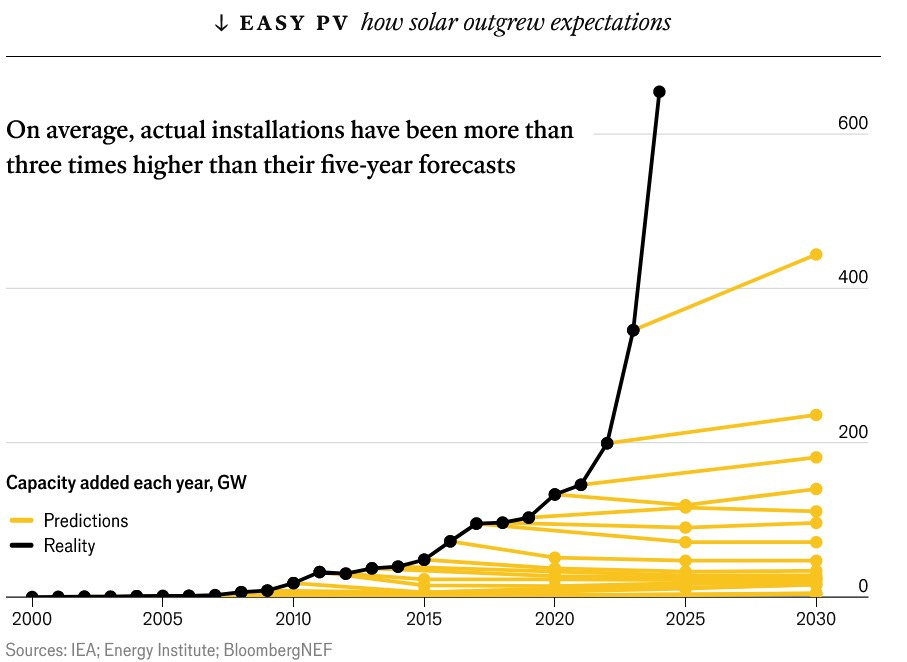
It's just one of the most amazing things in the world. I write about it weekly, have done for years, and it's just, like — it is ridiculous that it's not on the front page of every newspaper every day how amazing this is, that we have a panel of glass that gets power from the sun, no moving parts, no emissions, and that it's starting to be really growing exponentially worldwide. That is just amazing.
Can you tell me more about the projects you're doing with American partners in disadvantaged parts of the U.S.?
Yeah, absolutely. Coalfield Development in West Virginia is such an amazing organization and project, and I think they're a great example. When we first started working with them, we helped install their first ever solar on a reclaimed coal plant. They are now managing, I think, an $80 million Build Back Better coalition investment from the government to do workforce development and solar across the entire state!
In the U.S., especially right now, there's so many funding streams and incentives around solar. But government funding is really difficult to manage for small grassroots organizations, it's really daunting to even have the capacity and time to apply, let alone manage a grant if you receive it. So we've worked with some of our partners to provide flexible counterpart funding to federal grants, to help them fill out the application and figure out what they need to do to be able to manage it. And then we do some leadership development and capacity support for organizations that do access this bigger funding, so that they have the internal staff expertise and capacity to be able to lead these projects.
Historically, you know, there's sort of a network of bigger organizations that know how to manage and and secure these government contracts, and they will often come to the local community organizations as like almost an afterthought, like “we need a local partner, let's just like find somebody and check that box.”
I think our role is to really support with flexible funding and technical assistance and those sort of things that they don't necessarily get from the large scale funders, to enable them to be the leaders of these projects, leaders of the solar transition, versus the community engagement “checkbox” that can sometimes happen. I think it is still a challenge for these really frontline and smaller grassroots organizations to access that kind of capital.
That is amazing. That is really a great example of what you mentioned earlier about being the catalyst - they now can access the federal level capital!
You’ve highlighted local community leadership, and I just love how there’s support for that really built into the technology. The fuel is free from the sun. The value of a solar panel goes primarily to its owner, not its manufacturer. You can't have a sudden angry dictator blocking the flow of sunlight. Well, hopefully not. There’s a huge amount of potential for decentralized community ownership inherent to the fact that you have on site power generation with solar.
So, the Inflation Reduction Act has obviously supercharged clean energy deployment and cleantech manufacturing across America. Are you eligible for some of the tax credits for individual or community solar on your projects in the U.S.? Is it cheaper to install solar in the U.S. now because of those tax credits, has that been something that you've noticed since 2022?
Absolutely. We have had a couple of partners where we have structured our grant agreements with them in such a way that allows them to be used as counterpart funding to unlock solar tax credits and other incentives. We have a U.S. project that just unlocked an additional $60,000 for their solar install! So it is pretty significant, depending on the size. You have to have unrestricted counterpart funding to be able to access that, and so again, the role of this kind of funding is really important in making sure that that is accessible to our partners.
But yes, it is. I'm seeing that happen more and more. And I hope that it continues. I mean, we're less than a month from the election. So there is an unease about the uncertainty of what will happen next. But at the moment, it's working well for our community partners.
What question haven't I asked that I should ask? What would you like to share?
We covered a lot of what I wanted to share with you so I think the only thing that I would say to wrap up is, really, that this is a space where we need more attention, more investment, and more work. The Honnold Foundation is investing between two and two and a half million dollars per year in the work that we support through grants and other programmatic support. And there are huge foundations with billions of dollars in their endowment that are holding back their investment for a rainy day. Looking at the global data on emissions and climate change, the rainy day has arrived.
So if people take anything from our approach and our work, it’s that the least we can do is take financial risks. If you feel like you’re overinvesting [in solar], you might just be adequately investing. I think we see from our grassroots community partners, this sense of urgency, because they are already experiencing some terrible impacts from climate change, more so than many of us living in the global north have experienced. I hope people take a sense of urgency from that.
It’s been great speaking with you. The work you were doing is extraordinary, bringing solar to communities that need it around the world. Thank you so much!
Thank you. Take care.




